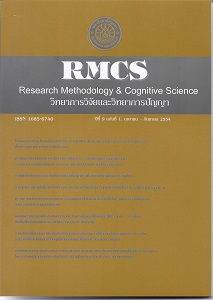ความยากของข้อสอบและความสามารถของผู้สอบที่สัมพันธ์กับ เวลาที่ใช้ในการตอบข้อสอบได้ถูกต้องของการทดสอบด้วยคอมพิวเตอร์
Main Article Content
Abstract
การวิจัยนี้มีวัตถุประสงค์เพื่อเปรียบเทียบเวลาที่ใช้ในการตอบข้อสอบได้ถูกต้องในการทดสอบด้วยคอมพิวเตอร์จําแนกตาม ความยากของข้อสอบและความสามารถของผู้สอบ กลุ่มตัวอย่างเป็นนักเรียนชั้นมัธยมศึกษาปีที่ 2 โรงเรียนปรีชานุศาสน์อําเภอเมือง จังหวัดชลบุรีปีการศึกษา 2554 จํานวน 60 คน จําแนกเป็นกลุ่มย่อย จํานวน 3 กลุ่มๆ ละ 20 คน คือ กลุ่มเก่ง กลุ่มปานกลาง และ กลุ่มอ่อน เครื่องมือที่ใช้ในการวิจัย ได้แก่ แบบทดสอบวิชาคณิตศาสตร์ชั้นมัธยมศึกษาปีที่ 2 และโปรแกรมการทดสอบด้วยคอมพิวเตอร์ วิเคราะห์ข้อมูลด้วยการวิเคราะห์ความแปรปรวนแบบ 2 ทาง (Two-Way ANOVA)
ผลการวิจัยแสดงว่า เวลาที่ใช้ในการตอบข้อสอบได้ถูกต้องมีความสัมพันธ์ทางตรงกับทั้งค่าความยากของข้อสอบและระดับ ความสามารถของผู้สอบ อย่างมีนัยสําคัญทางสถิติที่ระดับ .05 โดยผู้สอบใช้เวลาในการตอบข้อสอบง่าย น้อยกว่าเวลาที่ใช้ตอบข้อสอบ ยากง่ายปานกลางและข้อสอบยาก และใช้เวลาตอบข้อสอบยากง่ายปานกลาง น้อยกว่าเวลาที่ใช้ในการตอบข้อสอบยาก ในทํานองเดียวกัน ผู้สอบกลุ่มเก่งใช้เวลาในการตอบข้อสอบได้ถูกต้องน้อยกว่ากลุ่มปานกลางและกลุ่มอ่อน ในขณะที่ผู้สอบกลุ่มปานกลางใช้เวลาในการตอบ ข้อสอบน้อยกว่าผู้สอบกลุ่มอ่อน นอกจากนี้ผลการวิเคราะห์ความแปรปรวนแบบสองทาง ยังแสดงให้เห็นว่า ไม่มีปฏิสัมพันธ์ระหว่างค่า ความยากของข้อสอบและระดับความสามารถของผู้สอบ ซึ่งชี้ให้เห็นว่าผู้สอบกลุ่มอ่อนสามารถทําข้อสอบยากได้ถูกต้องเช่นกัน ถ้าให้เวลา ในการตอบข้อสอบมากกว่ากลุ่มปานกลางและกลุ่มเก่ง
Item Diffi culty and Student Ability Related to Correct Answer Response Time on Computer–Based Testing
Natthamon Saengjamrus1, Seree Chadcham2 and Poonpong Suksawang2
1Preechanusas school, Chon Buri, Thailand
2Centre for Applied Measurement College of Research methodology and Cognitive Science, Burapha University, Thailand
The purpose of this study was to compare item response time in computer – based testing as a function of student ability level and item diffi culty. Sixty grade eight students of Preechanusas school in Chon Buri in the academic year 2010 participated in the study. They were divided into high, medium, and low ability levels on the basis of total test score, with 20 students per group. The test was the Mathematics Test of Grade 8. It was delivered to the students using a computer–based testing system. SPSS was used to test descriptive statistics and test two-way analysis of variance.
The results showed that item response time was directly related to both item diffi culty and student ability level. Easy items took less response time than did medium-diffi culty items, which, in turn, took less response time than diffi cult items. A similar situation was found for ability levels: low-ability students took longer to response than did medium- ability students, who in turn took longer to respond than those of high ability. A two-way analysis of variance revealed that these differences were statistically signifi cant at the .05 level, with no interaction found between item diffi culty and ability level. Therefore, the results implied that low-ability students could do diffi cult items correctly if they were allowed to take more time than the medium-ability and high-ability students.
